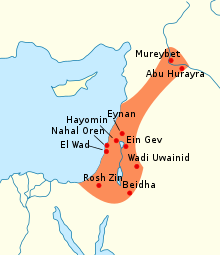Natufian
 |
|
| Geographical range | Levant |
|---|---|
| Period | Epipaleolithic |
| Dates | c. 12,500–9,500 BC |
| Type site | Shuqba cave (Wadi an-Natuf) |
| Major sites | Shuqba cave, Ain Mallaha, Ein Gev, Tell Abu Hureyra |
| Preceded by | Kebaran |
| Followed by | Khiamian, Shepherd Neolithic |
| The Mesolithic The Epipaleolithic |
|---|
| ↑ Paleolithic |
|
| ↓ Neolithic ↓ Stone Age |
The Epipaleolithic Natufian culture /nəˈtuːfiən/ existed from around 12,500 to 9,500 BC in the Levant, a region in the Eastern Mediterranean. It was unusual in that it supported a sedentary or semi-sedentary population even before the introduction of agriculture. The Natufian communities may be the ancestors of the builders of the first Neolithic settlements of the region, which may have been the earliest in the world. Natufians founded Jericho which may be the oldest city in the world. Some evidence suggests deliberate cultivation of cereals, specifically rye, by the Natufian culture, at Tell Abu Hureyra, the site of earliest evidence of agriculture in the world. Generally, though, Natufians exploited wild cereals. Animals hunted included gazelles. According to Christy G. Turner II, there is archaeological and physical anthropological evidence for a relationship between the modern Semitic-speaking populations of the Levant and the Natufians.
Dorothy Garrod coined the term Natufian based on her excavations at Shuqba cave in Wadi an-Natuf, in the western Judean Mountains.
The Natufian culture was discovered by British archaeologist Dorothy Garrod during her excavations of Shuqba cave in the Judaean Hills. Prior to the 1930s, the majority of archaeological work taking place in Palestine was biblical archaeology focused on historic periods, and little was known about the region's prehistory. In 1928, Garrod was invited by the the British School of Archaeology in Jerusalem (BSAJ) to excavate Shuqba cave, where prehistoric stone tools had been discovered by a French priest named Alexis Mallon four years earlier. She discovered a layer sandwiched between the Upper Palaeolithic and Bronze Age deposits characterised by the presence of microliths. She identified this with the Mesolithic, a transitional period between the Palaeolithic and the Neolithic which was well represented in Europe but had not yet been found in the Near East. A year later, when she discovered similar material at el-Wad Terrace, Garrod suggested the name the Natufian culture, after the Wadi an-Natuf that ran close to Shuqba. Over the next two decades Garrod found Natufian material at several of her pioneering excavations in the Mount Carmel region, including el-Wad, Kebara and Tabun, as did the French archaeologist René Neuville, firmly establishing the Natufian in the regional prehistoric chronology. As early as 1931, both Garrod and Neuville drew attention to the presence of stone sickles in Natufian assemblages and the possibility that this represented very early agriculture.
...
Wikipedia
